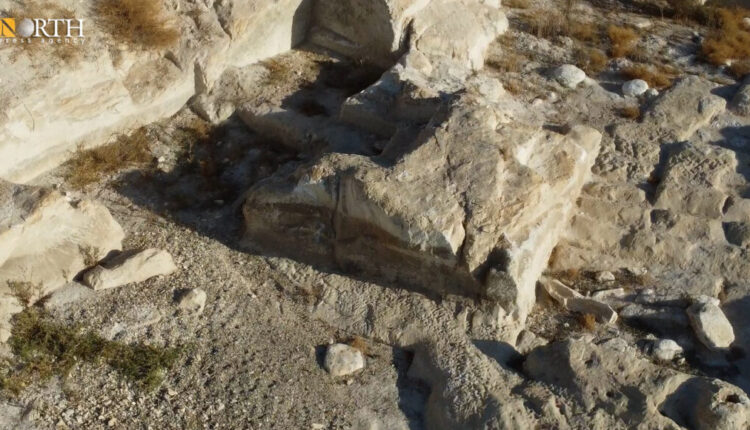
By Fayyad Muhammad / Ahmad al-Nasser
TABQA, Syria (North Press) – After the water level of the Euphrates River and lake receded by dozens of meters to record lows, archaeological sites emerged in the lake that stretches for 80 km behind the 60-meters high Euphrates Dam.
The Euphrates Dam is located in the city of Tabqa, northern Syria, with a lake that used to be eight km wide. After the decline in the water level of the Euphrates, the lake receded significantly by hundreds of meters, and even more towards the west.
Syria is famous for thousands of historical sites and cities, many of which were built on the banks of the Euphrates River. Some sites were submerged under water after the construction of the Dam, which is considered the largest in Syria.
Ancient burials extending from the Ja’bar Castle to the Shams al-Din area west of the town of al-Jarniyah, 65 km west of Tabqa, were submerged by the water of the lake.
Resurfaced
After the Euphrates’ water receded, it revealed professionally unexcavated ancient sites that had been hidden for decades, according to archaeologists.
These burials, approximately 25 km west of the historical Ja’bar Castle, extend along the riverbank to the administrative borders of Aleppo Governorate, northwestern Syria.
The archaeological burial sites date back to ancient vanished civilizations that existed on the banks of the Euphrates. In one of the burials, a gate leads to a staircase ending in smaller pockets, used as tombs.
The burial site was made by drilling a large hole in the rock, from which smaller pockets branched and were used for burying bodies. Some were used by royalties and influential families, and others for commoners. Moreover, the dead were buried with their precious possessions.
Before, some of these burials were visible but after the water of the lake receded, even more sites appeared. Elders from the nearby area said they witnessed excavation teams working in these burials before the construction of the dam.
According to their ancestors, when Syria was under the French mandate, all archaeological sites were looted, especially the burials, which suffered from vandalism by French soldiers.
Random excavation
In recent times, these sites were subjected to random excavations and vandalism by the Islamic State (ISIS). They used heavy machineries and excavators to search for antiquities, which they relied on as a source of funding.
Elderly residents pointed out that the excavation carried out by ISIS resulted in damage and alterations to the shape of the burials.
Yasser Shuhan, expert in archaeology, told North Press that many archaeological sites were subjected to unsystematic vandalism. He added that awareness programs should be implemented to revive interest in the archaeology and history.
Sulaiman Elias, another expert in archaeology, said that Antiquities, like other aspects of life, were impacted by the armed conflict in the Syria since 2011, as the rate of tampering with archaeological sites amounted to more than 50 percent.
Moreover, over 15 percent of archaeological sites in Syria in general have been damaged, including those in northeastern Syria, according to Elias.
Burials
Jassim al-Ahmad an official at the Antiquities Protection Office in Tabqa affiliated with the Autonomous Administration of North and East Syria (AANES), said these burials have various patterns and forms. They were looted during the French colonial period. He added that they believe these burials have been looted multiple times.
He told North Press that based on their shape, some of these sites resemble the Byzantine-style, and others the Roman style, with both depicting Christian features.
Each burial site contains multiple tombs according to the number of family members. They vary from three tombs in some burials to 13 tombs in others. These tombs have suffered from vandalism and attacks during the successive controlling parties over the area.
Inside a royal burial in the village of al-Garaa, about 30 km northwest of Tabqa, important archaeological inscriptions dating back to the Syriac age were found.
Al-Ahmad told North Press they conduct regular inspection tours on archaeological sites, in addition to appointing guards to protect them.
The discovery was nothing new, as the region contains many archaeological sites, and is already famous for the prevalence of antiquities dating back to civilizations that embraced Christianity, he added.
Muhammad al-Jabal, official in the Directorate of Tourism and Antiquities Protection in Tabqa, said that archaeological sites near the River banks were present before the dam was built. These sites were submerged after the dam was constructed, but the recession of the water led to their appearance. In turn, we documented these archaeological sites.
He added that all visible sites were previously registered by UNESCO and that recently a new site had been added.
